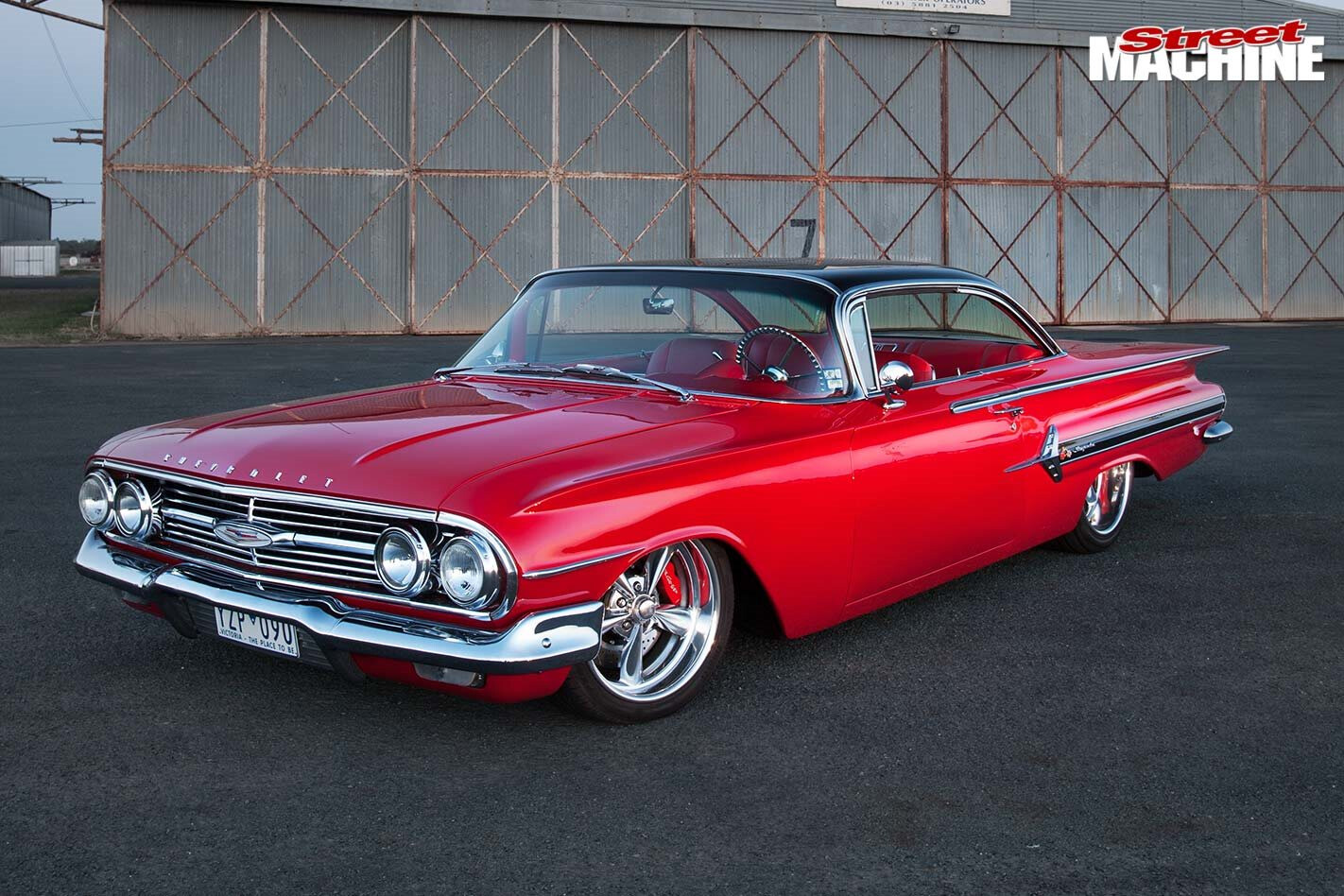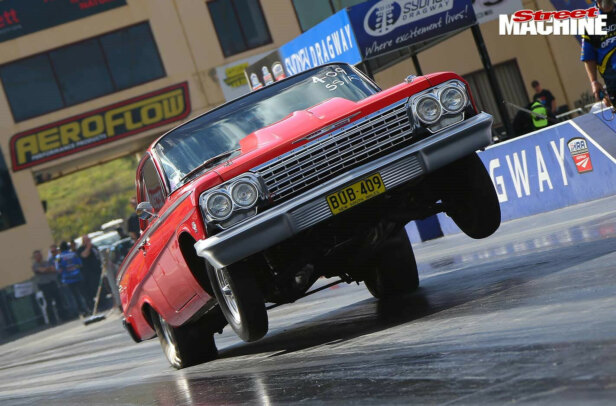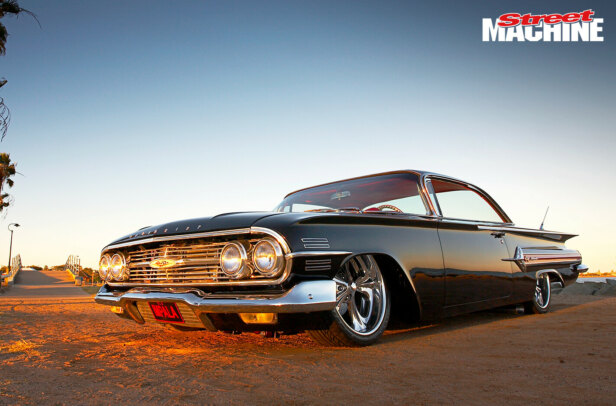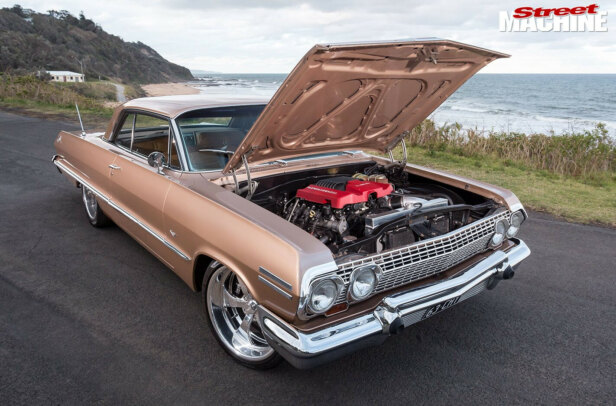OF ALL the Chevs, this is the best shape if you like cruising.” So says the owner of this killer 1960 Bubbletop Impala. That’s a bold statement, especially considering Chevrolet stunners such as the ’57 Chev, ’59 Caddy and all the early Corvettes are universally recognised as automotive works of art.
This article was first published in the May 2013 issue of Street Machine
Shane began building the Chev for himself but Chris liked it so much, he just had to have it. After convincing Shane to sell the half-finished car, he left it with SRC to complete the project. Smiles all ’round
But when the guy making that statement is Chris Retzos, who owns one of the world’s best examples of a ’57 Chev (SM, Oct ’09) and the ballistic 2000hp Coronet from our February issue, you have to concede that he knows what he’s talking about.
“I love this car,” he says. “It’s perfect for cruising or just heading out for a coffee. I love driving it; it’s serious head-turner. Even my son, who’s into Nissan GTRs, reckons it’s a cool old tank to drive.”
So what’s the deal? Bright red paint, spruced interior and dumped on airbags?
She’s not just a pretty garage ornament — and that’s a good thing as she looks even better out on the open road. The 540ci big-block adds the vital soundtrack
“If only it was that simple,” the builder, Shane Rowe of Southern Rod & Custom, says. “To get it to sit and drive so low, everything had to be raised.”
The killer stance starts with the factory chassis. Up the centre of GM’s ‘whalebone’ chassis is a tubular section, through which the tailshaft runs. The top of this had to be chopped out and raised to prevent the tailshaft fouling at full drop. That meant raising the tunnel in the body itself. While fabricating the new, taller tunnel, SRC kept going and chopped out the Impala’s entire floor, replacing it with a flat piece that sits appreciably higher.
The guys also incorporated a step up under the back seat to provide ample clearance for the two Flowmaster mufflers. They even used oval exhaust pipe to gain a vital few extra millimetres of clearance.
Up front, SRC modified the ball-joint mounts to stop them bottoming out and binding at full drop, which would destroy them. They then reworked the double A-arm front end and three-link rear end to accommodate an AirRide Shockwave at each corner — all controlled by a digital AccuAir system.
There’s plenty of room under the stock rear arches to swallow fat rubber, so it’s not tubbed as such. However, the height and shape of the inner wells was an issue. SRC had to square them off to allow the 20×10 hoops — wrapped in 275/40ZR20 rubber — to tuck way up inside the body.
As Chris says, the 1960-’61 Bubbletop is one of the coolest profiles to ever emerge from Chevrolet’s design studios, so there was no need to mess with the bodylines. Instead, SRC concentrated on making those lines sharper and cleaner; no factory 60s iron ever had such good shut lines or bodywork.
The chrome trim was inspired by the boot mould. Above the diff are the tank and pump for the airbags, plus the 12in subwoofer. On the right-hand side is the battery and on the left are two amplifiers on a fabricated steel frame
The oh-so-sexy red hue is PPG SRC Red. “Les Lawry’s Vicky, my ’57 and the Bubbletop are all very similar in colour but all slightly different,” Chris says. “This is the third car in the bunch, so I call it SRC Red version III.”
Offsetting the red are black details in the side and boot mouldings and the black roof. These accents really give the car a longer and leaner look. “The black and red combination makes it look great at night and even better out in the sun,” Chris says.
Eradicating 50 years of road rash from the body mouldings was a considerable undertaking. Unfortunately, Steve’s Metal Polishing, which normally takes care of SRC’s mould restorations, was unavailable when this project started.
Elegant engine bay uses a flat firewall, recessed booster, factory-style PWR alloy radiator and a stout 540ci big-block sporting Edelbrock twin-fours
“I tried a new mob,” Shane says. “They did a great job of repairs but not so great with polishing. Guy number two got them much brighter but also warped them. In the end I had to wait until Steve’s was available. They did the final tweaking and got them flawless.”
Both the bars were in pretty good nick, and Albury Electro Platers chromed them to perfection. The grille, however, was unsalvageable.
“We started buying grilles from the States,” Shane says. “Each one was in a little bit better than the last. Eventually I came across a new old stock grille at considerable expense but when it landed, it was just the aluminium facia. I had to drill out all the rivets from the good sections of the steel supporting structure from the other grilles, assemble the jigsaw puzzle and rivet it all back together. I pretty much used three grilles to make one.”
Powering the elegant tank is a stroked 502ci big-block Chev crate engine. It was bought used and sent off to Deniliquin Offroad/Marine to address a few oil leaks. Turned out it’d spun a bearing.
After failing to track down a reasonably priced 502 crank, rod and piston set, the consensus was to stick a Scat stroker kit in it. Bingo — 540 cubes!
While screwing it back together, they added alloy heads, a low-rise twin-carb inlet and a pair of four-barrels, all from Edelbrock. The result is grunty enough to sound tough, yet mild-mannered enough for relaxing cruising.
Hauling it all to a stop are 355mm rotors clamped by meaty six-piston Baer calipers driven by a Wilwood master cylinder coupled to a Gemini booster.
Unlike the exterior, inside it’s far from stock and features one the sweetest interiors you’ll ever lay eyes on. The metal upper part of the dash is mostly stock but has been smoothed off, while the lower section was re-worked to take three outlet vents for the Vintage Air a/c that’s tucked up under the dash. Cables running off the factory heater controls actuate the Vintage Air’s vacuum servos.
Front seats are 1961 Thunderbird; the stylish aluminium mouldings and classic slim design make them SRC favourites. Leather door trims are based on the factory design, with custom armrests. Height of the rear seat squab is roughly standard; the frame was modified to clear the raised floor section
Aftermarket Hanaline gauges were a direct fit into the Impala’s gauge binnacle and look right at home. A Budnik steering wheel tops a Flaming River column that connects to a Flaming River steering box that is completely re-engineered and features a variable ratio. This improves feel and eliminates the usual boat-like steering. “It’s very nice to drive,” Chris says, “even out on the crappy B-roads around Echuca.”
Bucket seats from a 1961 Thunderbird look cool and are favourites with SRC. Due to the raised floor height, Shane paid particular attention to their height and angle, along with the layout of the pedals and steering wheel — vital for a relaxing driving position.
Low-profile modern seat frames mount the buckets nice and low, while providing plenty of adjustability, and the column’s tilt function completes the puzzle.
With original handles and mouldings, the door trims look factory but they’re far from it.
Gavin Hill trimmed them in the same red leather used throughout the interior and added factory-inspired stitch lines and a factory stainless moulding before finishing them off with custom armrests.
For a laid-back cruiser, a kick-arse sound system is a must. The JVC CD/tuner features iPod connectivity and Bluetooth. Signals are fed into a four-channel Alpine amp powering two sets of six-inch splits, one pair in the front kick panels, the other in the parcel tray. A mono-block amp powers a 12-inch subwoofer.
“Although it doesn’t like the rain, I actually drive this sucker,” Chris says. “With the sound of the big-block, it’s got that muscle feel, yet it’s perfect for chucking the grandkids in the back, winding the windows down and going cruising down main street. It’s a cool car — I wouldn’t change a thing!”
CHRIS RETZOS
1960 CHEVROLET IMPALA
Colour: PPG SRC Red III
MAKIN’ IT MOVE
Engine: Chev 540ci
Heads: Edelbrock alloy Performer RPM
Intake: Edelbrock Performer RPM
Ignition: MSD dizzy and coil
Carbies: Edelbrock 600cfm x2
Cooling: PWR alloy
Exhaust: SRC custom headers & Flowmaster 2½in mufflers
Accessories: Billet Specialties serpentine
Fuel: PULP
UNDERNEATH
Gearbox: Turbo 400, Stage II shift kit
Diff: Nine-inch, Strange Trac-Loc centre
Tailshaft: Three-inch two-piece, billet centre bearing support
STOP & GO
Airbags: Air Ride Shockwave (f&r)
Suspension: Twin A-arm (f), three-link (r)
Brakes: Baer six-piston calipers & 355mm rotors (f&r)
COMFORT ZONE
Wheel: Budnik Knife
Seats: T-Bird 1961
Carpet: Virgin Himalayan yak wool
Column: Flaming River with shifter
Gauges: Hanaline electronic
ROLLING STOCK
Rims: Billet Specialties Rebel SLC77, 18×8 (f), 20×10 (r)
Pirelli, 235/35 (f), 275/40 (r)




Comments